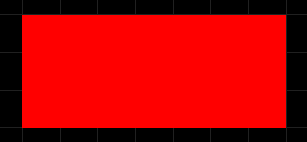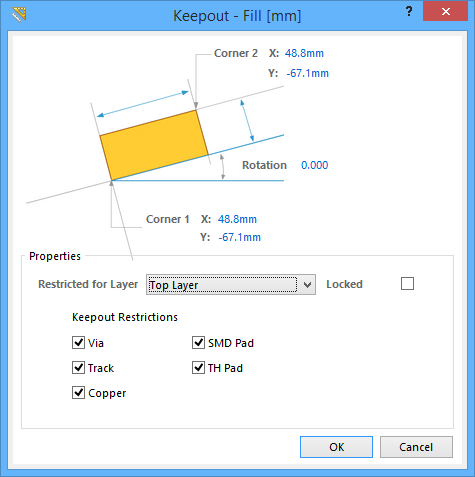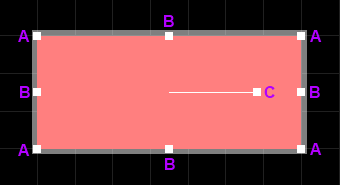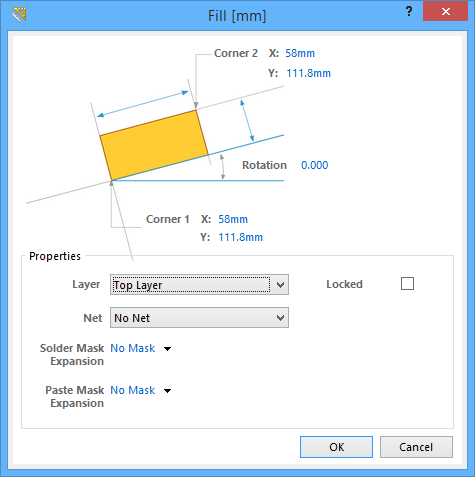Fill
Parent page: PCB Objects

A placed Fill.
Summary
A fill is a rectangular object that can be placed on any layer. When placed on a signal layer, a fill becomes an area of solid copper that can be used to provide shielding or to carry large currents. Fills of varying size can be combined to cover irregularly shaped areas, and can also be combined with track or arc segments and be connected to a net.
Fills can also be placed on non-electrical layers. For example, place a fill on the Keep-Out layer to designate a 'no-go' area for autorouting. Place a fill on a Power Plane, Solder Mask, or Paste Mask layer, to create a void on that layer. In the PCB Library Editor, fills can be used to define component footprints.
Availability
Fills are available for placement in both PCB and PCB Library Editors:
- PCB Editor - the following methods of access are available:
- Choose Place » Fill from the main menus.
- Choose Place » Keepout » Fill from the main menus.
- Click the
 button on the Wiring toolbar.
button on the Wiring toolbar.
- PCB Library Editor - the following methods of access are available:
- Choose Place » Fill from the main menus.
- Choose Place » Keepout » Fill from the main menus.
- Click the
 button on the PCB Lib Placement toolbar.
button on the PCB Lib Placement toolbar. - Right-click in the workspace and select Place » Fill from the context menu.
Placement
After launching the command, the cursor will change to a cross-hair and you will enter fill placement mode. Placement is made by performing the following sequence of actions:
- Click or press Enter to anchor the first corner of the fill.
- Move the cursor to adjust the size of the fill, then click or press Enter to anchor the diagonally-opposite corner and complete placement of the fill.
- Continue placing further fills, or right-click or press Esc to exit placement mode.
Additional actions that can be performed during placement are:
- Press the L key to flip the fill to the other side of the board – note that this is only possible prior to anchoring the fill's first corner.
- Press the + and - keys (on the numeric keypad) to cycle forward and backward through all visible layers in the design respectively – to change placement layer quickly.
- Press the Tab key to access an associated properties dialog, from where properties for the fill can be changed on-the-fly.
Placing a Fill as a Keepout
Using the Place » Keepout » Fill command, a Fill can be placed as a layer-specific keepout object or an all-layer keepout to act, for example, as a placement or routing barrier. Objects defined as keepouts are ignored during output generation, such as photo plotting and printing.
Keepout properties and restrictions can be assigned using the Keepout - Fill dialog.
To access the Keepout - Fill dialog, press Tab during placement. After placement, access the dialog by double-clicking on the Keepout Fill or right-click and select Properties from the context menu.

Graphical Editing
This method of editing allows you to select a placed fill object directly in the workspace and change its size, shape or location, graphically.
When a fill object is selected, the following editing handles are available:

A selected Fill.
- Click and drag A to resize the fill in the vertical and horizontal directions simultaneously.
- Click and drag B to resize the fill in the vertical and horizontal directions separately.
- Click and drag C to rotate the fill about its center point.
- Click anywhere on the fill – away from editing handles – and drag to reposition it. While dragging, the fill can be rotated or mirrored:
- Press the Spacebar to rotate the fill anti-clockwise or Shift+Spacebar for clockwise rotation. Rotation is in accordance with the value for the Rotation Step, defined on the PCB Editor – General page of the Preferences dialog.
- Press the X or Y keys to mirror the fill along the X-axis or Y-axis respectively.
Non-Graphical Editing
The following methods of non-graphical editing are available:
Editing via an Associated Properties Dialog
Dialog page: Fill
This method of editing uses the following dialog to modify the properties of a fill object.

The Fill dialog can be accessed prior to entering placement mode, from the PCB Editor – Defaults page of the Preferences dialog. This allows the default properties for the fill object to be changed, which will be applied when placing subsequent fills.
During placement, the dialog can be accessed by pressing the Tab key.
After placement, the dialog can be accessed in one of the following ways:
- Double-clicking on a placed fill object.
- Placing the cursor over a fill object, right-clicking and choosing Properties from the context menu.
- Using the Edit » Change command and clicking once over a placed fill object.
Via an Inspector Panel
Panel page: PCB Inspector, PCB Filter, PCBLIB Inspector, PCBLIB Filter
An Inspector panel enables the designer to interrogate and edit the properties of one or more design objects in the active document. Used in conjunction with appropriate filtering - by using the applicable Filter panel, or the Find Similar Objects dialog - the panel can be used to make changes to multiple objects of the same kind, from one convenient location.
Via a List Panel
Panel page: PCB List, PCB Filter, PCBLIB List, PCBLIB Filter
A List panel allows the designer to display design objects from one or more documents in tabular format, enabling quick inspection and modification of object attributes. Used in conjunction with appropriate filtering - by using the applicable Filter panel, or the Find Similar Objects dialog - it enables the display of just those objects falling under the scope of the active filter – allowing the designer to target and edit multiple design objects with greater accuracy and efficiency.
